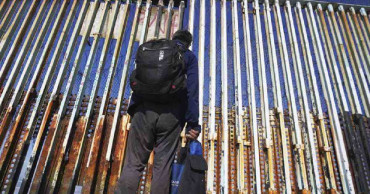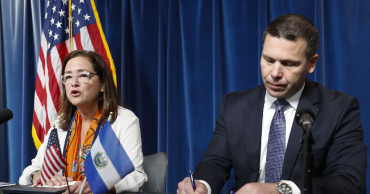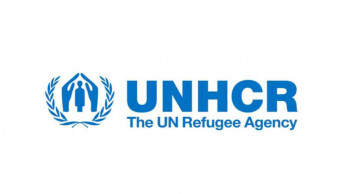Asylum
Asylum seeker accommodation in UK ‘racialised segregation and de facto detention’: Report
Asylum seekers in the United Kingdom who complain about poor conditions in Home Office assigned hotels were threatened with “being sent to Rwanda,” according to a new report by charity group Refugee Action.
The report, titled “Hostile Accommodation: How the Asylum System Is Cruel By Design”, consists 100 in-depth interviews with asylum seekers conducted in hotels in London, Manchester, the West Midlands, and Bradford, reports The Guardian.
It contains interviews with single persons and families, extensive casework records relating to problems in hotels and other asylum accommodations, and freedom of information (FOI) requests to council environmental health departments.
In addition to being advised not to complain about terrible living conditions or expect deportation to Rwanda, asylum seekers were also told that if they complained about the quality of food supplied to them, police would be contacted.
Read More: EU+ saw 1 million asylum applications, including record 34,000 from Bangladeshis, in 2022
They were also barred from taking photos of the food, it said.
The system of housing asylum seekers, which presently accommodates over 50,000 people, is “a nationwide system of racialised segregation and de facto detention,” said the report.
Asylum seekers are increasingly being kept in hotels for extended periods. One in every three people and one out of every four families with children stays in a hotel for more than a year.
In one example, a family of six lived in a single room for over a year. The report cautioned that if the new immigration bill, now being debated in parliament, is passed, the situation would deteriorate.
Read More: Online system to seek asylum in US is quickly overwhelmed
Individual cases highlighted in the report include a wheelchair user trapped on the 11th floor of a hotel because of a malfunctioning lift and an accommodation contractor who advised a GP not to write a health support letter for an asylum seeker advocating for a transfer because it would put a strain on the contractor’s accommodation system.
Infestations of pests and rodents were prevalent, as were moisture, mildew, and floods. Ceilings have also collapsed resulting in one woman holding a baby and a child being rushed to the hospital in two different occurrences.
“The government is running a system of de facto detention – holding and segregating people seeking asylum in accommodation that is harming their mental and physical health. This demoralising and brutal system costs the taxpayer millions per day but creates huge profits for contractors who are too often failing to make their housing habitable,” said Tim Naor Hilton, chief executive of Refugee Action.
Read More: UNHCR issues non-return advisory for Afghanistan
“We do not recognise the claims in the report suggesting hospitalisations, threats of deportation or restriction of movements, but where concerns are raised about any aspect of the service delivered by the hotel we work with the provider to ensure they are addressed in a timely manner,” a UK Home Office spokesperson said.
2 years ago
EU+ saw 1 million asylum applications, including record 34,000 from Bangladeshis, in 2022
In 2022, EU+ countries received some 966,000 applications, including 34, 000 from Bangladeshis, for international protection, up more than 50 percent from 2021, and the most since 2016, according to the new analysis of the European Union Agency for Asylum (EUAA).
The largest applicant groups were Syrians, Afghans and Turks, but applications were also high for a wide range of other nationalities, while the caseload of applications pending decision hit its highest level since 2017.
The EUAA analysis represents a significant increase in 2021, by around half, and is owed in part to the removal of Covid-related restrictions and longer-term underlying trends such as conflicts and food insecurity in many regions of origin, resulting in strong push factors. Furthermore, secondary movements within the EU and significant numbers of applications by nationals from visa-free countries who arrived legally contributed as well.
It comes in addition to around 4 million people fleeing Ukraine who benefit from temporary protection.
In activating the Temporary Protection Directive, the decision to offer a dedicated channel that does not require an individual examination of protection needs prevented the collapse of Europe's asylum systems. However, the combined five million people seeking protection in Europe have placed its national reception systems under considerable pressure.
Syrians (132,000) and Afghans (129,000) remained by far the largest applicant groups, and nationals of both countries lodged substantially more applications than in 2021, in fact, the most since 2016.
The EUAA recently issued Country Guidance on Syria and Afghanistan, with conclusions largely substantiating the protection needs of Syrian nationals, and finding inter alia that restrictions placed on Afghan women by the Taliban amount to persecution.
With more than doubling numbers, Turkish applicants (55,000) became the third largest group. They were followed by Venezuelans (51,000) and Colombians (43, 000), who both lodged about three times as many applications as in 2021.
Read more: Apparel export to EU grew 15.04 % during July-Jan of FY23
Turks, Venezuelans, Colombians, Bangladeshis (34,000), and Georgians (29,000) all applied the most on record.
At lower levels, record applications were also lodged by citizens of India (26,000), Morocco (22,000), Tunisia (21,000), Egypt (15, 000), Moldova (8,300), and several others.
In 2022, EU+ asylum authorities issued some 632,000 decisions at first instance, up by a fifth from 2021.However, applications increased by far more – in fact outnumbering them by about 333,000 – resulting in the largest gap since 2015. It largely translated into an increase in pending cases at first instance.
At the end of the year, some 636, 000 cases were awaiting a decision at first instance, a 44 percent increase compared to 2021.
The EU+ recognition rate was 40 percent in 2022, up by five percentage points from 2021 and the most in five years. Of the two-in-five applicants receiving a positive decision at first instance, around 147 000 were granted refugee status and 106 000 received subsidiary protection.
Recognition rates were especially high for Syrians, Belarusians, Ukrainians, Eritreans, Yemenis, and Malians.
In contrast, recognition rates were especially low for citizens of India, North Macedonia, Moldova, Vietnam, Tunisia, Bosnia and Herzegovina, Serbia, and Nepal among others.
Equipped with a strengthened mandate to support the implementation of the Common European Asylum System (CEAS), in 2022 the Agency substantially increased its technical and operational support.
The number of countries benefiting from the EUAA Operational Support has quadrupled to 13 EU member states since just 2019, with over 1,500 deployed personnel. The agency is also providing support in a third country, Moldova.
2 years ago
Online system to seek asylum in US is quickly overwhelmed
Hours before sunrise, migrants at one of Mexico’s largest shelters wake up and go online, hoping to secure an appointment to try to seek asylum in the U.S. The daily ritual resembles a race for concert tickets when online sales begin for a major act, as about 100 people glide their thumbs over phone screens.
New appointments are available each day at 6 a.m., but migrants find themselves stymied by error messages from the U.S. government's CBPOne mobile app that's been overloaded since the Biden administration introduced it Jan. 12.
Many can’t log in; others are able to enter their information and select a date, only to have the screen freeze at final confirmation. Some get a message saying they must be near a U.S. crossing, despite being in Mexico’s largest border city.
At Embajadores de Jesus in Tijuana, only two of more than 1,000 migrants got appointments in the first two weeks, says director Gustavo Banda.
Also Read: Leaders of US, Canada, Mexico show unity despite friction
“We're going to continue trying, but it's a failure for us,” Erlin Rodriguez of Honduras said after another fruitless run at an appointment for him, his wife and their two children one Sunday before dawn. “There's no hope.”
Mareni Montiel of Mexico was elated to select a date and time for her two children — then didn't get a confirmation code. “Now I'm back to zero,” said Montiel, 32, who has been waiting four months at the shelter, where the sound of roosters fill the crisp morning air at the end of a rough, dirt road.
CBPOne replaced an opaque patchwork of exemptions to a public health order known as Title 42 under which the U.S. government has denied migrants’ rights to claim asylum since March 2020. People who have come from other countries find themselves in Mexico waiting for an exemption or policy change — unless they try to cross illegally into the U.S.
Also Read: Biden intends to make his first visit to US-Mexico border
If it succeeds, CBPOne could be used by asylum-seekers even if Title 42 is lifted as a safe, orderly alternative to illegal entry, which reached the highest level ever recorded in the U.S. in December. It could also discourage large camps on Mexico's side of the border, where migrants cling to unrealistic hopes.
But a range of complaints have surfaced:
— Applications are available in English and Spanish only, languages many of the migrants don't speak. Guerline Jozef, executive director of the Haitian Bridge Alliance, said authorities failed to take "the most basic fact into account: the national language of Haiti is Haitian Creole.” U.S. Customs and Border Protection says it plans a Creole version in February; it has not announced other languages.
— Some migrants, particularly with darker skin, say the app is rejecting required photos, blocking or delaying applications. CBP says it is aware of some technical issues, especially when new appointments are made available, but that users’ phones may also contribute. It says a live photo is required for each login as a security measure.
The issue has hit Haitians hardest, said Felicia Rangel-Samponaro, director of The Sidewalk School, which assists migrants in Reynosa and Matamoros, across from Texas' Rio Grande Valley. Previously, about 80% of migrants admitted to seek asylum in the area were Haitian, Rangel-Samponaro said. On Friday, she counted 10 Black people among 270 admitted in Matamoros.
“We brought construction lights pointed at your face,” she said. “Those pictures were still not able to go through. ... They can't get past the picture part.”
— A requirement that migrants apply in northern and central Mexico doesn't always work. CBP notes the app won't work right if the locator function is switched off. It's also trying to determine if signals are bouncing off U.S. phone towers.
But not only is the app failing to recognize that some people are at the border, applicants outside the region have been able to circumvent the location requirement by using virtual private networks. The agency said it has found a fix for that and is updating the system.
— Some advocates are disappointed that there is no explicit special consideration for LGBTQ applicants. Migrants are asked if they have a physical or mental illness, disability, pregnancy, lack housing, face a threat of harm, or are under 21 years old or over 70.
Still, LGBTQ migrants are not disqualified. At Casa de Luz, a Tijuana shelter for about 50 LGBTQ migrants, four quickly got appointments. A transgender woman from El Salvador said she didn't check any boxes when asked about specific vulnerabilities.
The U.S. began blocking asylum-seekers under President Donald Trump on the grounds of preventing the spread of COVID-19, though Title 42 is not applied uniformly and many deemed vulnerable are exempted.
Starting in President Joe Biden’s first year in office until last week, CBP arranged exemptions through advocates, churches, attorneys and migrant shelters, without publicly identifying them or saying how many slots were available. The arrangement prompted allegations of favoritism and corruption. In December, CBP severed ties with one group that was charging Russians.
For CBPOne to work, enough people must get appointments to discourage crossing the border illegally, said Leon Fresco, an immigration attorney and former aide to Senate Majority Leader Chuck Schumer, a Democrat.
“If these appointments start dragging out to two or three or four months, it's going to be much harder to keep it going,” he said. “If people aren’t getting through, they won’t use the program.”
CBP, which schedules appointments up to two weeks out, declines to say how many people are getting in. But Enrique Lucero, director of migrant affairs for the city of Tijuana, said U.S. authorities are accepting 200 daily in San Diego, the largest border crossing. That's about the same as the previous system but well below the number of Ukrainians processed after Russia's invasion last year.
Josue Miranda, 30, has been staying at Embajadores de Jesus for five months and prefers the old system of working through advocacy groups. The shelter compiled an internal waiting list that moved slowly but allowed him to know where he stood. Banda, the shelter director, said 100 were getting selected every week.
Miranda packed his suitcases for him, his wife and their three children, believing his turn was imminent until the new online portal was introduced. Now, the Salvadoran migrant has no idea when, or if, his chance will come. Still, he plans to keep trying through CBPOne.
“The problem is that the system is saturated and it's chaos," he said after another morning of failed attempts.
2 years ago
US Supreme Court keeps asylum limits in place for now
The Supreme Court is keeping pandemic-era limits on asylum in place for now, dashing hopes of migrants who have been fleeing violence and inequality in Latin America and elsewhere to reach the United States.
Tuesday’s ruling preserves a major Trump-era policy that was scheduled to expire under a judge’s order on Dec. 21. The case will be argued in February and a stay imposed last week by Chief Justice John Roberts will remain in place until the justices make a decision.
The limits, often known as Title 42 in reference to a 1944 public health law, were put in place under then-President Donald Trump at the beginning of the pandemic, but unwinding it has taken a torturous route through the courts. The U.S. Centers for Disease Control and Prevention attempted to end the policy in April 2022, but a federal judge in Louisiana sided with 19 Republican-led states in May to order it kept in place. Another federal judge in Washington said in November that Title 42 must end, sending the dispute to the Supreme Court. Officials have expelled asylum-seekers inside the United States 2.5 million times on grounds of preventing the spread of COVID-19.
Immigration advocates sued to end the policy, saying it goes against American and international obligations to people fleeing to the U.S. to escape persecution. They’ve also argued that the policy is outdated as coronavirus treatments improve.
READ: US plans for more migrant releases when asylum limits end
The Supreme Court’s 5-4 decision comes as thousands of migrants have gathered on the Mexican side of the border, filling shelters and worrying advocates who are scrambling to figure out how to care for them.
“We are deeply disappointed for all the desperate asylum seekers who will continue to suffer because of Title 42, but we will continue fighting to eventually end the policy,” said Lee Gelernt, a lawyer with the American Civil Liberties Union, which had been arguing to end Title 42′s use.
Andrea Rudnik, co-founder of non-profit immigration aid organization Team Brownsville in South Texas, said the situation at the border is a humanitarian crisis. She said there are thousands of migrants camped on cardboard boxes and in makeshift tents near the entrance of the Gateway International Bridge in Matamoros, Mexico, opposite Brownsville, without food, water, clothing or bathrooms.
“It is very readily becoming a dangerous situation because there’s no toilets,” Rudnik said. “Get that many people together with no bathrooms and you know what you have got.”
States that wanted Title 42 kept in place hailed the outcome. In a press release Tuesday, Iowa Gov. Kim Reynolds praised the court’s decision while saying it’s not a permanent solution to the country’s immigration woes.
“I’m grateful that Title 42 remains in place to help deter illegal entry at the US southern border. But make no mistake — this is only a temporary fix to a crisis that President Biden and his administration have ignored for two years,” she said.
The Supreme Court’s decision said that the court will review the issue of whether the states have the right to intervene in the legal fight over Title 42. Both the federal government and immigration advocates have argued that the states waited too long to intervene and — even if they hadn’t waited so long — that they don’t have sufficient standing to intervene.
In the dissent, Justices Neil Gorsuch and Ketanji Brown Jackson wrote that even if the court were to find the states have the right to intervene and Title 42 was lawfully adopted “... the emergency on which those orders were premised has long since lapsed.”
The justices said the “current border crisis is not a COVID crisis.”
“And courts should not be in the business of perpetuating administrative edicts designed for one emergency only because elected officials have failed to address a different emergency. We are a court of law, not policymakers of last resort,” the justices wrote.
READ: Mega Millions Tuesday jackpot surpasses estimated $565M
Justices Elena Kagan and Sonia Sotomayor also voted to deny the stay but did not sign a dissent.
White House press secretary Karine Jean-Pierre said Tuesday that President Joe Biden’s administration “will, of course, comply with the order and prepare for the Court’s review.”
“At the same time, we are advancing our preparations to manage the border in a secure, orderly, and humane way when Title 42 eventually lifts and will continue expanding legal pathways for immigration,” Jean-Pierre added. “Title 42 is a public health measure, not an immigration enforcement measure, and it should not be extended indefinitely.”
In November, a federal judge sided with advocates and set a Dec. 21 deadline to end the policy. Conservative-leaning states appealed to the Supreme Court, warning that an increase in migration would take a toll on public services and cause an “unprecedented calamity” that they said the federal government had no plan to deal with.
Roberts, who handles emergency matters that come from federal courts in the nation’s capital, issued a stay to give the court time to more fully consider both sides’ arguments.
The federal government asked the Supreme Court to reject the states’ effort while also acknowledging that ending the restrictions abruptly would likely lead to “disruption and a temporary increase in unlawful border crossings.”
The precise issue before the court is a complicated, largely procedural question of whether the states should be allowed to intervene in the lawsuit. A similar group of states won a lower court order in a different court district preventing the end of the restrictions after the Centers for Disease Control and Prevention announced in April that it was ending use of the policy.
Until the judge’s November order in the advocates’ lawsuit, the states had not sought to take part in that case. But they say that the administration has essentially abandoned its defense of the Title 42 policy and they should be able to step in. The administration has appealed the ruling, though it has not tried to keep Title 42 in place while the legal case plays out.
The Biden administration still has considerable leeway to enforce Title 42 as aggressively or as leniently as it chooses. For example, when a judge ordered last year that Trump’s “Remain in Mexico” policy to make asylum-seekers wait in Mexico for hearings in U.S. immigration court be reinstated, it did so with such limited scope that it had little impact. That policy ended in August after the administration prevailed in the Supreme Court.
The Biden administration’s use of Title 42 includes an opaque, bewildering patchwork of exemptions that are supposed to be for migrants deemed most vulnerable in Mexico, perhaps for gender identity or sexual orientation, or for being specifically threatened with violence. U.S. Customs and Border Protection works with partners it doesn’t publicly identify and doesn’t say how many slots are made available to each.
READ: 48 deaths reported in US from massive storm
Mexico is another wild card. The use of Title 42 to quickly expel migrants depends largely on Mexico’s willingness to accept them. Right now Mexico takes expelled migrants from Guatemala, Honduras, El Salvador and Venezuela, in addition to Mexico, but not other countries, such as Cuba. Most asylum seekers who cannot be sent to Mexico are not expelled.
Biden is scheduled meet with Mexican President Andres Manuel López Obrador in Mexico City next month.
3 years ago
US plans for more migrant releases when asylum limits end
The Department of Homeland Security said more migrants may be released into the United States to pursue immigration cases when Trump-era asylum restrictions end next week in one of its most detailed assessments ahead of the major policy shift.
The department reported faster processing for migrants in custody on the border, more temporary detention tents, staffing surges and increased criminal prosecutions of smugglers, noting progress on a plan announced in April.
But the seven-page document dated Tuesday included no major structural changes amid unusually large numbers of migrants entering the country. More are expected with the end of Title 42 authority, under which migrants have been denied rights to seek asylum more than 2.5 million times on grounds of preventing spread of COVID-19.
A federal judge in Washington ordered Title 42 to end Dec. 21 but Republican-led states asked an appeals court to keep it in place. The Biden administration has also challenged some aspects of the ruling, though it doesn't oppose letting the rule lapse next week. The legal back-and-forth could go down to the wire.
Homeland Security Secretary Alejandro Mayorkas traveled this week to El Paso, Texas, which witnessed a large influx Sunday after becoming the busiest corridor for illegal crossings in October. El Paso has been a magnet for Venezuelans, Nicaraguans, Cubans, Colombians, Ecuadoreans and other nationalities.
The geographic shift to Texas' westernmost reaches was likely a result of smugglers' calculations on the best route, said Nicolas Palazzo, an attorney at Las Americas Immigrant Advocacy Center in El Paso.
Like other advocacy groups that work directly with directly with Homeland Security, Palazzo said he has had no conversations with the department about post-Title 42 planning. One key question: How will authorities process migrants who have long been waiting to seek asylum?
U.S. Rep. Henry Cuellar, D-Texas, said Customs and Border Protection officials told him Wednesday that about 50,000 migrants are believed to be waiting to cross once Title 42 is lifted.
Read more: Those wanting to travel to US as visitor or student should apply as early as possible: Embassy
Authorities plan to admit those seeking asylum who go through ports of entry but return to Mexico those who cross illegally between official crossings, Cuellar said in an interview. It was unclear how they will return nationalities that Mexico won't accept — like Cubans and Nicaraguans — and are difficult to send home due to strained diplomatic relations and other challenges.
Administration officials are developing additional measures, which Cuellar said they would not disclose.
“I think the first week is going to be a little bit of chaos,” he said.
U.S. officials in El Paso are currently exempting 70 migrants daily from Title 42, said Palazzo, who questioned how officials will handle more people.
Unless they raise processing capacity significantly, migrants who go through official crossings may be told to wait a year or so for an appointment, said Palazzo. “Realistically can they tell me with a straight face that they expect people to wait that long?”
In its latest assessment, CBP said government agencies “have been managing levels well beyond the capacity for which their infrastructure was designed and resourced, meaning additional increases will create further pressure and potential overcrowding in specific locations along the border.”
More single adults and families with young children may be released into communities with instructions to appear in immigration court without help of nongovernmental groups or financial sponsors, the department said.
The department didn't indicate how many migrants may cross the border when Title 42 ends. Earlier this year, they expected as many as 18,000 a day, a staggering number. In May, migrants were stopped an average of 7,800 times a day, the peak month of Joe Biden’s presidency.
In the fiscal year that ended Sept. 30, migrants were stopped 2.38 million times, up 37% from 1.73 million times the year before. The annual total surpassed 2 million for the first time.
The numbers reflect deteriorating economic and political conditions in some countries, relative strength of the U.S. economy and uneven enforcement of Trump-era asylum restrictions.
3 years ago
Federal judge halts preparations for end of US asylum limit
A federal judge ordered a two-week halt Wednesday on the phasing out of pandemic-related restrictions on seeking asylum — and raised doubts about the Biden administration’s plan to fully lift those restrictions on May 23.
For now, the decision is only a temporary setback for the administration. But the judge staked out a position that is highly sympathetic with Louisiana, Arizona and 19 other states that sued to preserve so-called Title 42 authority, which denies migrants a chance at asylum on grounds of preventing the spread of COVID-19.
“(The states) have established a substantial threat of immediate and irreparable injury resulting from the early implementation of Title 42, including unrecoverable costs on healthcare, law enforcement, detention, education, and other services for migrants,” wrote U.S. District Judge Robert Summerhays in Lafayette, Louisiana.
Summerhays, who was appointed by former President Donald Trump, said states were likely to succeed with their argument that the administration failed to adhere to federal procedures when it announced April 1 that it was ending Title 42 authority.
The judge has scheduled a critical hearing on May 13 in Lafayette to hear arguments on whether to block Title 42 from ending as planned 10 days later.
Texas filed a similar lawsuit filed Friday in federal court in Victoria, Texas.
Also Read: Tougher US asylum policy follows in Europe's footsteps
The decision to end Title 42 authority was made by the federal Centers for Disease Control and Prevention. It has come under growing criticism from elected officials in Biden’s Democratic Party who contend the administration is unprepared for an anticipated increase in asylum-seekers.
The Justice Department declined to comment on the order but the administration has said it will comply, while contending it will hamper preparations for Title 42 to end on May 23.
About 14% of single adults from Guatemala, Honduras and El Salvador were processed under immigration laws during a seven-day period ending last Thursday. That’s up from only 5% in March, according to government figures.
Summerhays’ order requires the Homeland Security Department to “return to policies and practices in place” before it announced plans to end Title 42 and to submit weekly reports that demonstrate it is acting “in good faith.”
Also Read: Judge won't block US asylum restrictions at southern border
Migrants have been expelled more than 1.8 million times under the rule invoked in March 2020 by the Trump administration. Migrants were stopped more than 221,000 times at the Mexico border in March, a 22-year-high that has raised concerns about the government’s ability to handle even larger numbers when Title 42 is lifted.
Advocates for asylum-seekers say the restrictions endanger people fleeing persecution back home and violates rights to seek protection under U.S. law and international treaty. As the CDC acknowledged, the public health justification for the order has weakened as the threat of COVID-19 has waned.
At two often-contentious hearings Wednesday, Department of Homeland Security Secretary Alejandro Mayorkas sought to defend the administration’s handling of an increase of migrants at the Southwest border and its plans to deal with the prospect of more with the potential end of Title 42.
Mayorkas sought to push back on Republican accusations that the Biden administration has encouraged irregular migration by allowing some people to seek asylum, blaming economic and political turmoil and violence throughout Latin America and the world.
“Some of the causes of irregular migration have only been heightened by years of distress preceding this administration,” he said.
Mayorkas testified one day after Homeland Security released a plan with more details about how it was preparing for the end of Title 42 authority.
3 years ago
UNHCR issues non-return advisory for Afghanistan
The UNHCR, the UN Refugee Agency, recently released a non-return advisory for Afghanistan, calling for a bar on forced returns of Afghan nationals, including asylum seekers who have had their claims rejected.
In the wake of the rapid deterioration in the security and human rights situation in large parts of the country and the unfolding humanitarian emergency, the UNHCR called on states to halt forcible returns of Afghan nationals who have previously been determined not to require international protection.
The UN agency said it was concerned about the risk of human rights violations against civilians in this evolving context, including women and girls, those perceived to have a current or past association with the Afghan government, international organisations or with the international military forces.
Also read: Afghans protest Taliban in emerging challenge to their rule
Since the beginning of the year, more than 550,000 Afghans have been internally displaced as a result of conflict and insecurity. While civilians have so far only fled sporadically in fewer numbers to countries neighbouring Afghanistan, the situation continues to evolve rapidly.
As the situation remains fluid and uncertain, the UNHCR called for access to the territory to allow civilians fleeing Afghanistan and to ensure respect for the principle of non-refoulement at all times – the prohibition on returning people to situations of danger.
States have a legal and moral responsibility to allow those fleeing Afghanistan to seek safety and not forcibly return refugees, the UNHCR said.
It has welcomed the recent actions taken by several states to temporarily halt deportations of failed asylum-seekers.
Also read: Afghans plead for faster US evacuation from Taliban rule
The UNHCR's advisory against forced returns to Afghanistan remains in effect until security, rule of law and human rights conditions improve enough in the country to allow for safe and dignified returns.
4 years ago
Fleeing coup, Myanmar refugees in India seek asylum
Police officers who defied the Myanmar army’s orders to shoot opponents of the coup and escaped to India are urging Prime Minister Narendra Modi’s government to not send them back and provide them political asylum on humanitarian grounds.
4 years ago
El Salvador says it's not ready to receive asylum seekers
El Salvador is not ready to receive asylum seekers from the United States and will not accept them until it can offer them the necessary protections and support, Foreign Minister Alexandra Hill Tinoco said Wednesday.
5 years ago
Refugees, asylum seekers risk their lives in search of safety: UNHCR
Dhaka, Oct 1 (UNB) – Refugees and asylum seekers in Southeast Asia face critical threats while seeking safety and a better future for themselves and their families, according to a report of UNHCR released on Tuesday.
6 years ago







.jpg)










